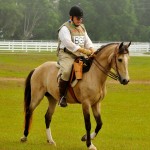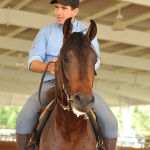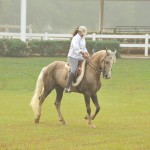(For anyone who was there at the clinic, I encourage you to try to hear our instructor’s voices while you read this! Please feel free to add anything you picked up in individual lessons. I have written about the gaits before, so I will not repeat those comments, but I’ll link to them in case you want MORE!)

The Mangalarga Marchador has 2 marching gaits. The Marcha is the same footfalls in both marcha picada and marcha batida.
The footfall sequence is
| 3 | 2 | 3 | 2 | 3 | 2 | 3 | 2 |
| RH RF LH | RF LH | RF LH LF | LH LF | LH LF RH | LF RH | LF RH RF | RH RF |
When the length of time spent in lateral supports is higher, then the gait is marcha picada. When the length of time is higher spent in diagonal supports is higher, then the gait is marcha batida. In both, there are moments of triple hoof support, which is what makes the gait smooth and easy to ride.
When the length of time spent in diagonal and lateral pairs are equal, it is sometimes described as marcha de centro.
To the human ear, in marcha picada, there is a much longer time (in lateral) between the footfalls making the 4 beats very distinctive and easily heard. In marcha batida, the marcha is still 4 beat, but the footfalls of the diagonal pairs land closer together making it harder to hear 4 distinct beats.
Training can help improve a Marchador’s natural gait, but genetics determine the innate quality and movement of the horse. Breeding for the center of the spectrum is the goal for a smooth and well-balanced movement.
Below is the gait spectrum:
Pace Marcha Picada /\ Marcha Batida Trot
(True lateral) CENTER (true diagonal)
Here is are some videos comparing the 2 gaits and you can HEAR the difference, although all Marchador gaits are smooth. These may not be the best examples of the MM breed, but I chose them because the horses were ridden on hard ground so you can hear as well as see.
Marcha Picada
Marcha de Centro (Marcha Batida)
Marcha Batida
“To help you feel and analyze the marcha, you need to use 5 things: 2 eyes, 2 ears and 1 seat.” says Tiago during the classroom lecture. Sometimes the marcha is not visible to a untrained human eye. The feet move too fast for us. The ears are very good to listen for the gait. And the seat, it should signal when the gait is smooth. As the rider, you try to put the horse in that place, and make that feeling and sound last for longer and longer periods of time.
“It is like a dance”. The horse must stay relaxed in the neck, but driving from behind. “So, the rider, he sets the boundary in front to make a door that is closed.” So, the horse moves into collection, but it is a give and take between the horse and rider, especially in the beginning, for the horse to stay relaxed and giving to the bit.
Okay, now we understood the diagram of the marcha.
The quality of the movement in Brasil is judged on many levels: the showiness of the gait (the C with the front legs), the diagram of the marcha (how close it comes to perfection in footfalls and timing), the length of the stride (they want it to be ground covering, extension is valued) and finally, the smoothness of the gait.
So, now how do you bring it out in your Marchador? For this, we relied on Kate’s individual riding instruction on the Marchadors brought to the clinic. Next post!



























